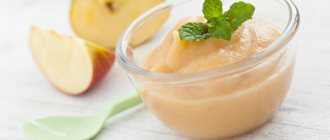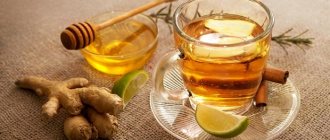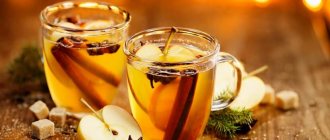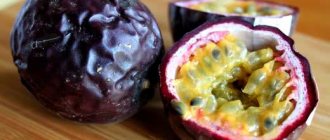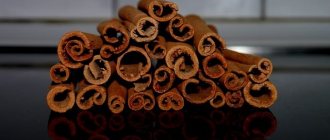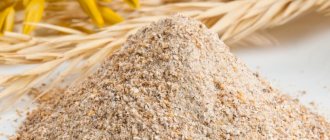Properties of lemonade
Nutritional value and composition | Vitamins | Minerals
How much does lemonade cost (average price for 1 liter)?
Moscow and Moscow region.
70 rub.
The distinctive cooling properties of the soft drink, as well as the benefits of lemonade, have long been known to mankind. Typically, lemonade is made from lemon with added sugar, and a carbonated drink is also more common. Lemonade dates back to the 17th century, when people began making the first lemonades. The lemonade drink got its original name from the English word Limonade. If you carry out a morphological analysis of the word, you will get the phrase Lemon added or literally “lemon added.”
Simple lemonade recipe
This is a fairly simple but very tasty recipe for Duchess lemonade. So, to prepare it you will need the following ingredients:
- 300 ml pear juice;
- 50 ml lemon juice;
- 100 g sugar;
- 350 ml sparkling water;
- a pack of vanilla.
Cooking method:
- First of all, you need to boil the syrup. To do this you need to prepare the fruit. We sort through and leave only whole fruits without damage. Cut the pears into small pieces and squeeze the juice out of them.
- Then sprinkle some of the juice with granulated sugar and add a little vanillin, just to enhance the aroma.
- Place the liquid on the fire and cook for a few minutes.
- As soon as the juice boils, stir it for 3 minutes and remove.
- Cool the resulting syrup.
- To the other part of the juice that is not cooked, add the juice of one or two squeezed lemons.
- Mix sparkling water, syrup and juice.
It is especially pleasant to drink this drink during a hot period with ice and an extra slice of lemon.
Composition of lemonade
Lemonade in the 17th century contained only a few ingredients. As a rule, it was lemon juice or tincture, as well as water. King Louis I of France was the first monarch in the history of lemonade to appreciate the drink. What’s noteworthy is that the composition of the lemonade was achieved thanks to a mistake that could have cost the court cupbearer his life. The man mixed up the barrels with wine and lemon juice, and when he noticed his mistake, it was already too late, because... the king was waiting for his wine.
Then the cupbearer added mineral water to the lemon juice. This is how the first lemonade turned out, the king fell in love with the drink, and the cupbearer not only remained alive, but also kept his job. The history of the creation of the first carbonated water is closely connected with the beginning of the industrial production of lemonade. The thing is that the industrialist Jacob Schwepp began to produce the first sweet soda for wide sale under the Schwepp & Co brand with lemon flavor.
At the beginning of the 19th century, carbonated lemonade became a top seller and enjoyed unprecedented popularity among customers. The first lemonade that was made industrially was called lemon-ginger ale. Nowadays, there are quite a few types of lemonades; some drinks contain other ingredients and components in addition to lemon.
The history of lemonade
This wonderful drink, so beloved by children and adults, was born in Paris. In those days, France was ruled by King Louis Bourbon, who was one of the first to taste this drink. Of course, the drink we are used to is different from what was drunk at the court of the French crown. Back then, lemonade was not carbonated and consisted of only three components: water, sugar and lemon juice.
In Russia, the appearance of lemonade is associated with the name of Peter the Great. And the appearance of gases in drinks is associated with the invention of a saturator by Joseph Priestley in the 18th century, which saturates water with carbon dioxide.
The harm of lemonade
However, in addition to the benefits, there is also harm from lemonade, and, as a rule, industrially produced drinks are considered hazardous to health. Manufacturers often crush costs through the quality of the product's original ingredients. Half of the periodic table can be found in modern store-bought lemonade.
In this case, the harm of lemonade will consist in the content of dyes, preservatives and taste stabilizers. Frequent consumption of lemonade leads to obesity, the development of diabetes, as well as increased excitability in children, aggressiveness and, as a result, increased fatigue.
Calorie content of Duchess lemonade
Any lemonade is, first of all, a carbonated drink that contains carbon dioxide, which creates bubbles that hit the nose. In Soviet times, siphons or soda slaked with citric acid were used to create these same bubbles. However, soda spoiled the taste of the drink, so over time they began to use carbonated water with syrup.
It is worth noting that the calorie content of homemade Duchess lemonade is low. Only 24 kcal per 100 g of drink, while 12 g are carbohydrates. To reduce the calorie content of the drink, you can use sugar substitutes or not sweeten it at all.
Italian lemonade
The Italians did not stand aside and created their own version of the pear drink. The Italian version of Duchess lemonade is prepared using exotic fruits such as grapefruit and mango. Thanks to these components, a drink with an unusual, tonic taste is obtained.
Required Products:
- 1 ripe grapefruit;
- 2 large pears;
- 1 small mango;
- a glass of raspberries;
- sugar syrup;
- lemon juice.
As in the previous recipe, a concentrate of fruits and berries is first prepared, which is diluted with highly carbonated water. This version of lemonade is usually generously decorated with pieces of fruit and whole raspberries.
Homemade Duchess lemonade will be an excellent drink that quenches thirst in hot weather, as well as the main table decoration for both children and adults.
Lemonade secrets
In the early 1930s. There were rumors that the founder of the lemonade brand, as well as the author of all the recipes, Mitrofan Lagidze, deliberately hid some of the secrets of preparing his product.
This situation did not suit the envious people, and denunciations began to pour in against Mitrofan from everywhere. But the Georgian magician managed to defend his honor and prove publicly that there is no special secret. He even made lemonade in Stalin’s own office. The leader tried it and said: “I don’t see any difference, which means there is no secret.”
Application
Lime attracts with its invigorating aroma and piquant sourness, but it is not eaten entirely, but is used to acidify and add a refreshing aroma to drinks and dishes. Lime juice or a slice is added to tea, cocktails, sauces, salads, served with fish and meat dishes, and is good as a snack for alcoholic drinks. Due to the fact that lime fruits have high acidity, they are not recommended for people with high stomach acidity, gastritis and ulcers. The acid contained in the pulp also destroys tooth enamel.
Market Analytics
- COVID-19 is changing the rules of the game in the cosmetics market
- Beauty of the future: cosmetic innovations 2020
- New ingredients are the driving force of the cosmetics industry
Convenient search for beauty salons on our website
Beauty salons in Moscow Beauty salons in St. Petersburg Beauty salons in Ekaterinburg Beauty salons in Novosibirsk
Latest blog posts on our website
- Naturecream / Geranium (Pelargonium) oil for skin health and beauty
- Prostye-sovety / Save on a beauty salon: procedures that can be done at home
- Naturecream / Growth Factor - brings back youth?
- Oksana-Lezina / 3 effective abdominal exercises from a fitness instructor for beginners
- Prostye-sovety / Making perfect curls at home
- Prostye-sovety / Which hair removal method to choose
- Naturecream / Wrinkles Puppets
- Naturecream / PEPHA-TIGHT - instant skin lifting
- Naturecream / Blue light - a danger to the skin
- Naturecream / Cocoa Butter – A treat for the skin
Latest forum topics on our website
- Mrs._Smith / Badly sunburned! What to do?((
- Ice / Is it necessary to combine fitness classes with a diet?
- Antonova / What can be used for hair loss?
- Radio operatorKat / Who was on a protein diet?
- Suzanna / Mesotherapy on the face
Other articles in this section
| Quince Fragrant, large and slightly tart quince is a surprisingly healthy fruit with healing powers. Its fruits have been known to mankind for hundreds of years, and in Ancient Greece, quince was especially revered for its beneficial properties and was considered a symbol of fertility. |
| Lingonberry Lingonberry is a low-growing evergreen shrub and rarely reaches a height of more than 30 cm. Lingonberry grows in coniferous and mixed forests, on hills and dried peat bogs in the northern regions of Russia. At the beginning of summer, small white-pink flowers with a faint, pleasant scent bloom in dense clusters at the tops of the branches. By the beginning of autumn, the fruits ripen - bright red spherical shiny berries with a large number of seeds. Lingonberries grow in clusters of 2 to 9 pieces and have a piquant taste with a slight bitterness. |
| Sea buckthorn Sea buckthorn is a shrub or small tree, reaching a height of 3 meters, the branches are covered with small thorns and densely located fruits on short stalks. The fruits of the plant are small oval berries of yellow-orange color with a refreshing sweet and sour taste and a pleasant aroma, vaguely reminiscent of pineapple. |
| Lychee Lychee is a tropical fruit from the Sapindaceae family, a relative of longan and rambutan. Lychee fruits are small in size, oval or round in shape. Ripe fruits have a dense, bumpy, red-brown skin, covered with a large number of sharp protrusions. The food used is white or milky pulp with a jelly-like consistency, inside of which there is a large oblong bone. Lychee pulp has a pleasant, refreshing sweet and sour taste and a delicious aroma. |
| Longan Longan is a tropical fruit from the Sapindaceae family, a relative of lychee and rambutan. The round-shaped fruits, about the size of a walnut, grow in clusters and are sold tied in bunches. Translucent, white or pinkish flesh of a jelly-like consistency with one large seed in the center is covered with a thin and dense peel that is easily peeled. The juicy and aromatic pulp of longan has a sweet taste with a hint of musk. The taste of the fruit varies and depends on the variety and place of growth: fruits grown in Thailand resemble grapes, and in Vietnam longan looks like a berry cocktail. In China, longan is called “longyan”, which translates as “dragon eye”. |
| Rambutan Rambutan is a tropical fruit from the Sapindaceae family, a relative of lychee and longan. The fruits are round in shape and up to 6 cm in diameter, growing in clusters of 25-35 pieces. Ripe fruits have a dense red-brown skin, covered with a large number of hard, crocheted hairs at the ends. The food used is white or milky pulp with a jelly-like consistency, inside of which there is a large oblong bone. The pulp of rambutan is juicy, sweet, with a slight sourness and a pleasant aroma. |
| Hawthorn Hawthorn is widespread and can be found in the undergrowth, ravines, along river banks, and on the edges of forests. Hawthorn blooms in early summer, and the fruits ripen by autumn. Hawthorn berries are about 1 cm in diameter, round or oval, hard, wrinkled. The color of the fruit is yellow, orange, dark red, brown, sometimes with a whitish coating. There is no smell, the pulp is mealy, sweet and sour with hard seeds. Hawthorn is a medicinal plant and all its parts are used in folk medicine: fruits, leaves, bark and flowers. |
| Blackberry Blackberry is the closest relative of the raspberry and belongs to the Rosaceae family. Blackberry bushes are the most common in nature; they are rarely grown in gardens. The plant blooms in early summer and blooms until autumn, so one bush simultaneously contains flowers, unripe fruits and ripe berries. Blackberries are multi-seeded berries of purple-black color, juicy, sweet and sour with a wonderful aroma. Blackberries are a very productive plant, and at the height of the summer season, its branches bend under the weight of ripe berries. |
| Apple pulp Juicy and aromatic apples are eaten in Russia all year round; this is the most common and most popular fruit. They are baked, jam and compote are made, jam is made, and put in pies. But fresh apples are most useful, since vitamins are partially destroyed during heat treatment. Therefore, it is worth paying special attention to freshly prepared apple juice and fresh apple puree. |
| Apple Apple trees are the most common fruit crop in the gardens of central Russia. Scientists count at least 10 thousand varieties of apple trees, which were obtained by crossing different varieties. All varieties are divided into summer, autumn and winter, which are well stored all winter. The fruits are predominantly yellow, green and red in color, have a round shape and weigh on average 100-150 g. Apples have thin skin and dense crispy flesh with a delicate aroma. The sweetness of apples depends on the chemical composition and the ratio of sugar and acid - the sugar-acid ratio. Sour and green fruits have a higher vitamin C content. |


